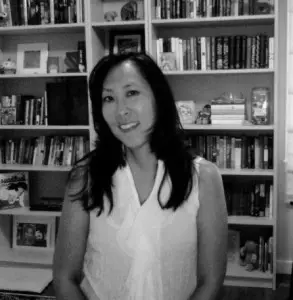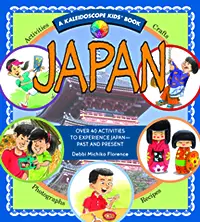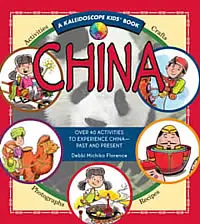 Debbi Michiko Florence is a third-generation Japanese-American author of children’s books. She was born in San Francisco in California. In this interview, Debbi talks about her books, her heritage, reading and writing.
Debbi Michiko Florence is a third-generation Japanese-American author of children’s books. She was born in San Francisco in California. In this interview, Debbi talks about her books, her heritage, reading and writing.
Voicu Mihnea Simandan: How has the (former) teacher become a writer of fiction and non-fiction books for children?
Debbi Michiko Florence: I’ve been writing stories all my life. Before I could write words, I drew stick-figure cartoon stories. From elementary school through high school, in between classes and assignments, I wrote short stories. I took creative writing classes in high school and in college, and read voraciously. It wasn’t until I married my second husband and moved to Mexico that I had the opportunity to write full time. I enjoyed being a classroom teacher and a zoo educator, but writing is my passion. I had a few adult short stories published in journals/magazines, but quickly found that my heart is with the young reader. I most love to read books for teens, so it follows that I most love to write for that age group.
VMS: Surprisingly, your first book was China: A Kaleidoscope Kids Book (2008), and not one about Japan! Why China first?
DMF: Good question. It so happened that I was living in Shanghai, China (for my husband’s job) at the time. An editor mentioned to a friend that she was looking for someone to write a children’s book about China and my friend gave her my name. After several conversations and a general outline (from me), I received a contract to write that book. It was fabulous being able to do research directly in the country I was writing about.
 VMS: Your second book, Japan: A Kaleidoscope Kids Book (2009), follows the same format. What did the Japan of your childhood look like?
VMS: Your second book, Japan: A Kaleidoscope Kids Book (2009), follows the same format. What did the Japan of your childhood look like?
DMF: I didn’t grow up in Japan, but I did have the opportunity to spend summers there visiting relatives when I was a child. I have fond memories of Tokyo visiting my mom’s brother and his family – the high rises, shopping for Hello Kitty toys before she was popular here in the States, and playing a “piñata” type game of hitting a watermelon with a stick to break it on a hot summer day. We also visited Hiroshima (my dad’s side of the family) where my aunt and uncle owned a store. I recall helping ringing up sales on an old fashioned register and being allowed to eat ice cream straight from the store freezer. My grandparents lived in a house on a mountain with a river running out front. My sister and I used to play in the cold water, looking for tiny fish behind rocks. My best memories, however, are of visiting Kabo, a small village on a small island called Oshima where my mother spent much of her childhood. My great aunt tended a small tangerine grove and her house was on the mountain side with a view of the ocean. We’d have to be careful of snakes and centipedes when we walked the path to the beach, past rice fields, and we’d spend hours cavorting in the sea.
VMS: In the light of the recent natural and nuclear disasters that have struck Japan, what thoughts do you have for the Japanese people?
DMF: My heart goes out to the people of Japan. It was a truly devastating disaster that is still taking its toll. I worry for the Japanese people’s safety and their recovery. I’m heading to Japan this fall and although I won’t be visiting any of the tsunami/reactor affected areas, I am anxious to see if there are noticeable differences from my last visit five years ago.
VMS: How much research went into these two kaleidoscope books?
DMF: It’s hard to measure, but A LOT! 🙂 I took pages and pages of notes (several legal pads full for each book). I probably could have researched forever, but I was on a deadline for both books. The deadlines helped motivate me to stop researching and start writing. I read many books, both for adults and children about both countries, covering history, art, holidays, religion, food, and more. I also did some research online, keeping a detailed bibliography for my editor. I conducted interviews when appropriate. My background in zoology and education came in handy while writing up the section on wildlife and in developing the activities for kids.
 VMS: You have started as a non-fiction author but you also write children’s fiction. How did you find the transition?
VMS: You have started as a non-fiction author but you also write children’s fiction. How did you find the transition?
DMF: In reality, it’s the other way around. Or maybe not. I started out as a travel writer for Victoria Brooks’ Greatest Escapes webzine when I was living in Mexico. That was my first valuable experience with working with an editor. I then wrote and had three adult short stories published in magazines/journals before committing to writing children’s fiction. It was soon after I signed with my wonderful agent, Jennifer DeChiara, with my fiction that the offer to write nonfiction came in. It wasn’t too hard to switch gears, and now I’m back to writing fiction again.
VMS: Some people believe that children no longer read and, with the availability of affordable e-readers, many believe that, sooner or later, children will no longer want to hold books in their hands. Please comment.
DMF: I don’t know about the statement that children no longer read. I’m surrounded by kids who love to read. As for e-readers, I read a study somewhere that teens today prefer books to e-readers. I do see with the younger set (ages 6 – 11), more reading being done on e-readers. As long as kids are reading, I’m happy. I for one am torn on the e-reader vs books debate. Because I travel frequently, having a Kindle has made a world of difference, lightening the load of my suitcase and giving me plenty to choose from to read on my travels. However, I love the feel and the smell of a book. Plus, I love getting books signed by authors. These days, because I live in a cozy (i.e. small) home, I have limited space. I still buy books by favorite authors and friends, but I also buy e-books to help save on shelf space.
VMS: You have an informative website. How important is it for writers these days to be “out there” on the Internet, interacting with their fans?
DMF: I don’t know of any studies done about the benefits of an author being available online, but I suspect it’s helpful. Kids today are web savvy and no doubt will Google their favorite author or book to find out more information. Recently I started a blog called DEBtastic Reads! that focuses on books I love and author interviews. I like to give back to the writing community and spread the love of reading and books. I appreciate people like you who give back in that way, too. Thank you!
VMS: You’ve also been on a few school visits. What were some of the highlights of these visits?
DMF: The kids, of course! 🙂 One of my first school visits was before I had a book published. I was asked to talk to students about conducting interviews (I have been doing author interviews for almost a decade now). One of the highlights of that visit was when after my talk, kids lined up to get my autograph. Even after I explained I wasn’t published yet, they still insisted! But, the best part of every school visit is the kids – the questions they ask, the stories they tell, the excitement on their faces.
VMS: Do you still read children’s books and young adult fiction?
DMF: Almost exclusively! I used to read 100 books a year, but life has gotten busier and I’ve been devoting more time to my own writing so I’m pleased if I can read 50 middle grade and young adult novels a year. I wish I could read all of the fantastic books out there! (I’m dangerous in a bookstore – dangerous to my bank account.)
VMS: What book are you working on right now?
DMF: I’m working alternately on a chapter book about a Japanese-American girl taking part in a New Year’s Day family tradition, and a young adult contemporary novel – it’s a first draft so I’m still working out what it’s about.
VMS: What is your writing routine?
DMF: I try to devote four days a week to writing. I take weekends off (to spend with my family) and leave one day during the week free for errands and social engagements. My most creative time is in the morning, so after checking e-mail and my social networks, I dive into my current project. I often will set a goal (usually a word count) for myself. Some days I write for a couple of hours, and other days I write for 4 hour stretches or more. While I write alone, I sometimes find it helpful (motivating) to work with a friend either in person or virtually. I sometimes meet up with a writing friend at the library where we set up in a room and write. Other days, I’ll log onto Skype with my writing partner (from my critique group) and we’ll check in at regular intervals to make sure we’re staying on task and not goofing off or procrastinating. I will work like that via email, too, with other writing friends. But, ultimately, I have to be self-motivated and focused to get my work done every day.
VMS: What advice would you give to aspiring writers?
DMF: Four things:
1. Have patience! There’s a lot of waiting involved with a career in writing. Waiting for “inspiration,” waiting for time to write, waiting for time in between drafts to gain some objectivity, waiting for a critique, waiting to hear back from a submission, and so on.
2. Be devoted to learning all you can about the craft and the business. I joined The Society of Children’s Writers and Illustrators immediately after deciding that I wanted to write for children. It was one of the smartest things I’ve done. Through the organization, I’ve learned a lot about the business and the craft of writing, attended conferences and workshops, volunteered, networked, and made a lot of good friends. I read a lot of craft and motivation books. Some of my favorites that I return to over and over are On Writing by Stephen King, Art & Fear by David Bayles and Ted Orland, and Bird by Bird by Anne Lamott.
3. Read. Read books in the genre you want to write. Read books outside of the genre you want to write. Read books for kids. Read books for adults. Read good books. Read crappy books. There’s something to be learned from every reading experience.
4. Write. That seems obvious, but sometimes it’s hard to get started. Just write.
VMS: Thank you for your time.
DMF: Thank you for having me!
Listen to Debbi talk about her two books:
Voicu Mihnea Simandan
Bangkok, Thailand
November 1, 2011



What a super interview–very in depth, and I appreciate gaining so much perspective on how a writer moves back and forth between different projects and fits writing into a busy life. Wishing Debbi all the best!
Thank you for taking the time to interview me! Great questions! I had fun answering them! Happy writing!
Thanks Debbi for your great answers too!
Great interview. It’s always interesting to see what different writers’ paths have looked like, as well as how they work.
It’s interesting, because I keep hearing about all these kids using e-readers to read books, but I have yet to see it myself. That’s probably a product of geography and the local economy.
Nice interview. Sorry to miss Debbie in Japan this visit. Loved reading about her childhood memories.
We bought “Japan, a Kaleidoscope kids’ book” when our son was 7, for a school country project. We didn’t know why he chose Japan. Last summer when he was almost 12 he went back to the book, taught himself two of the Japanese alphabets and spent hours poring over the book and trying to write. With the summer holidays round the corner he’s found the book again. We are thrilled he has been inspired by this. Thank you very much Debbie Michiko Florence